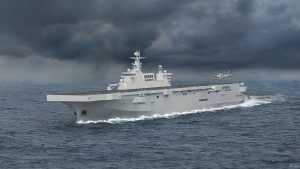China’s new big amphibious warship has finally taken to sea. The first Type 075 amphibious assault ship appears to have embarked on sea trials as of early last week. A second ship is fitting out, and a third may be launched before the end of the year.
Over the past 15 years China has rapidly expanded its amphibious capabilities, with the construction of eight Type 071 amphibious transport docks and the doubling of the size of its marine corps. Moreover, China appears to be building ships more rapidly than the United States.
The Type 075 is 237 meters long, and displaces some 40,000 tons, making them slightly smaller than either the Wasp- or America-class amphibs of the United States. Reportedly, the amphibs can carry 900 troops plus heavy equipment and landing craft, with an aviation component of up to 30 helicopters. As the U.S. Navy has maintained since the conversion of the first flat-decked amphibs in the 1960s, while such ships lack the high-end capabilities of modern large carriers, they can perform a multitude of tasks from amphibious assault to humanitarian assistance/disaster relief to anti-submarine warfare to combat air support. As of yet, China lacks either a STOVL fighter (like the Harrier or the F-35B) or a STOVL transport (like the MV-22 Osprey), but the ships nevertheless offer Beijing useful new tools of influence.
The entry into service of the new Chinese amphib makes for a stark contrast with the apparent loss of the USS Bonhomme Richard to a shipyard fire in San Diego. Although Bonhomme Richard would have been more capable than the new Chinese ships because of its ability to operate F-35B fighters, otherwise the two ships would have been quite comparable in capabilities. For its part, in April the first Chinese ship had its own minor fire, although the apparent damage was rapidly repaired and the fire did not seem to slow progress on construction.
The commissioning of the three ships will place China firmly in the second rank in terms of global amphibious capabilities, second only to the United States and ahead of regional competitors such as Japan and South Korea. Beijing can use the ships to increase its political influence in Southeast Asia and the Indian Ocean, to support operations on small islands, and even to threaten Taiwan. The United States still maintains a substantial advantage in overall ship numbers, sophisticated aircraft, and training and experience. However, it comes at a time when the U.S. Navy and Marine Corps have begun to reconsider the value of big amphibs, and both Japan and South Korea have turned their gaze toward light aircraft carriers. Before long, the PLAN could have the dominant amphibious capability in the Western Pacific.

































